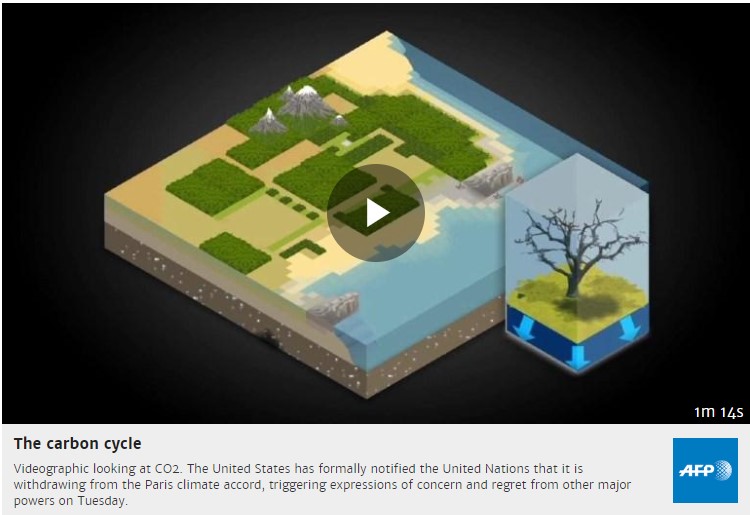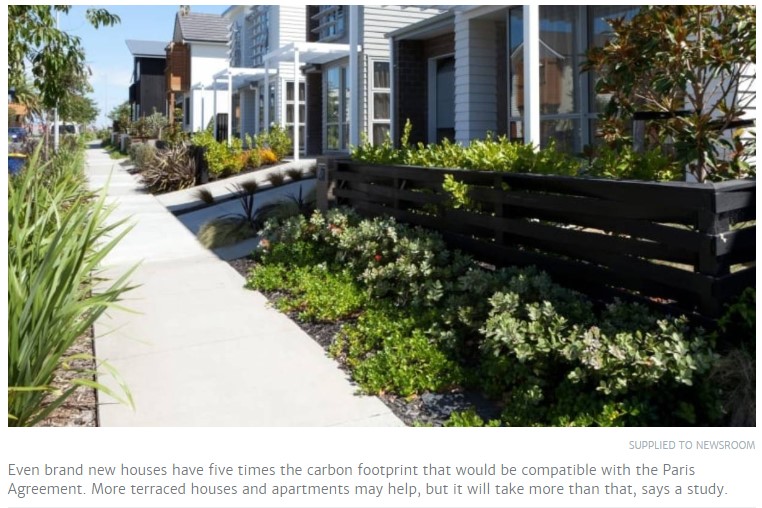
This story was originally published on Newsroom.co.nz and is republished with permission.
Researchers have calculated how much carbon dioxide a typical new three-bedroom home can afford to emit in its lifetime and still keep the world within 2 degree Celsius warming.The bad news is, New Zealand houses are five times over-budget. The good news is, we can fix it (probably).

A typical new Kiwi home emits five times as much carbon dioxide as it can afford to, if the world is to stay inside 2C warming.
A first-of-its-kind New Zealand study says housing must shrink its carbon footprint by 80 per cent to do its bit to meet the Paris climate accord.
“I was actually surprised it wasn’t worse,” says Sarah McLaren, a carbon-budgeting researcher and professor in life cycle management at Massey University, who helped lead the study. “Reducing to 20 per cent of what we’ve got now, I feel it’s doable. If the target was a thousandth of what it is now, it would make you want to give up. This feels like a challenge that can be taken up,” she says.
The study was supported by the Building Research Association of New Zealand, whose principal scientist, David Dowdell, also helped do the research. The study’s lead author was Chanjief Chandrakumar and BRANZ’s Roman Jaques also helped.
Like McLaren, Dowdell found the results reassuring. “I totally agree. What it has shown us is that this is possible.”
The researchers wanted to know how the carbon footprint of a typical, new Kiwi home compared to what an ideal footprint would be, one that’s compatible with the Paris 2C warming limit.
The 2C cap was agreed by virtually all countries as a (theoretically) realistic target that would avoid the worst impacts of severe ice melt, wildfires, drought, sea level rise, storm damage and food insecurity from climate change. Buildings are a big part of meeting countries’ emissions goals, since, globally, constructing and using buildings accounts for almost a third of greenhouse gases. Demand for new housing is expected to grow between now and 2050.
But while most people know about the Paris goal, it can be hard to translate the broad 2C number into anyone’s daily life. A slew of studies are now working back from the target, to show people how it might apply to different aspects of their lives. McLaren and Dowdell say they wanted to show what doing our bit to stay within 2C could mean for New Zealand housing.
Their study focuses on detached houses, since they make up 80 per cent of our stock.
New Zealanders tend to build unusually big and spaced-apart houses, which drives up their emissions. The typical Kiwi home is a detached, one-storey, three-bedroom dwelling with a 166 square metre floor area, the study says, and the size of a typical newly-built house is expected to grow further, to 198 sq m.
To work out an ideal carbon budget for a new, New Zealand home, the researchers first took the total carbon dioxide that everyone in the world could emit by 2050 and still stay inside 2C warming. They divvied up the allowance by head of global population. They then took New Zealand’s national allocation, and divided this between different sectors.
Although New Zealand’s overall emissions must shrink by 2050, the researchers assumed housing would maintain its current share of a shrinking emissions pie. They also assumed new housing and existing housing would maintain their respective shares of overall housing emissions. (Currently, about 34 percent of housing’s emissions are from newly-constructed buildings, versus 66 percent from existing houses, which greatly outnumber new homes).
The researchers used projections of how many new homes would be built by 2050, the year by when New Zealand aims to be carbon neutral. They assumed new homes would be built to the building code, without climate-friendly add-ons such as added insulation or natural cooling. As well as counting construction emissions, they factored in the climate impact of the energy used inside houses for heating, lighting, cooking and plugging in appliances.
After all this, they had a target: A typical newly-built detached house of 198 m2 in size could afford to emit 55,280 kg of carbon dioxide over its estimated 90-year lifetime. Since there aren’t 90 years left between now and 2050, each home was apportioned a share of its lifetime budget to represent its emissions over next 30 years.
How badly are today’s new homes blowing the ideal carbon budget? Using life cycle analyses of three typical new houses, the researchers calculated the footprint of a new detached house was about five times the limit.
But the news was not all bad, McLaren and Dowdell told Newsroom.
It’s true that the sheer size of an average new Kiwi house makes it more carbon-intensive than it could be – both to build, and to keep warm and comfortable. “It means more materials, it means more space that needs to be heated or cooled, and more to maintain,” says Dowdell.
Yet the study showed New Zealand homes were at the low end internationally for their lifetime carbon emissions, thanks to a combination of a benign climate, at least in Auckland, and the fact New Zealanders have traditionally favoured using more wood and fewer bricks and concrete in their houses. Timber creates lower emissions than bricks and concrete during manufacturing and construction, with the added bonus that trees grown to make timber also suck carbon from the air.
Compared with other countries, New Zealand homes also have the advantage of a largely low-emissions electricity grid, which cuts the climate impact of household power use and any locally-manufactured building materials.
Energy use inside the home was the biggest portion of the footprint, closely followed by construction. Over the 30 years to 2050, construction emissions were almost evenly balanced with household energy, while, over the longer-term, household energy use dominated the footprint, says Dowdell.
“If you look over the 90-year life of a house, by far the largest contributor is the energy use in the house,” he says. “The two things contributing the most are plug-loads, so the TV, dishwasher, fridge, washing machine, all those devices, and the other big item is heating of water. The next big one, depending where you are in New Zealand, is heating, and that’s more of an issue in Christchurch and Wellington than it is in Auckland,” Dowdell says.
“After energy use, is construction. The materials have a large and immediate effect, because if you’re going to build a new house all the materials that go into that house are being manufactured within a short period of time and being transported to the construction site. So, if we look at emissions over the 30 years — between now and 2050 — for a house that’s being built this year, almost half of the emission will be the materials.”
The study also looked at the carbon footprint of all housing, including existing homes. By coincidence, the housing sector as a whole was also about five times over the 2C budget. The researchers say that highlighted the importance of making existing homes more energy-efficient, as well as building better new ones.
“There are things we can do quickly to get the carbon down,” says Dowdell. “The big one is the house size. There is a close relationship between house size and carbon footprint.”
“Then, making houses more energy efficient, especially in places like Wellington and further south. Orienting our houses so they get good winter sun and making sure there is shading in summer, using good high-spec double-glazed windows that are well installed. Simple things like that don’t add much to the cost. They cut the carbon, but typically we are not doing them in a routine way.”
Dowdell acknowledged it would take more than those few simple things, to shrink New Zealand housing’s carbon footprint to 20 percent of its current size.
But broader social changes would also help – bringing the electricity grid closer to being all-renewable, using an electric fleet of vehicles to move building materials, using better materials, and more energy-efficient appliances.
Then there’s high density living — a relatively new concept for many New Zealanders. “The trend is to higher density housing. There are some trade-offs there, in that as we start to build higher, we use material with higher embodied carbon such as concrete or steel. We need to do more work on that. But getting the size down and having higher density living also provides other carbon benefits in terms of allowing people to live in proximity to jobs and transport hubs. Can we start to plan (cities) in ways that are lower-carbon and higher density but give people the amenities they want? It’s a challenge,” says Dowdell. “Nobody is saying we all have to be in apartments, we can still have detached housing, but we need to find ways to do that that allows us to stay in our carbon budget.”
The researchers plan to carry out similar calculations for New Zealand apartments, and terraced housing.
McLaren says similar carbon budgeting methods can also be applied to other sectors, such as food production and transport, to help people grasp what committing to 2C might look like.
For now, says Dowdell, having a housing carbon budget gives people working in building, design and construction a starting point to discuss.
“Suddenly, there is a number there that people can relate to.”
This story was originally published on Newsroom.co.nz and is republished with permission.
Newsroom

